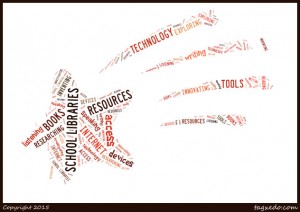 The BACC bloggers are experimenting with exploring a shared topic each month. We will share various perspectives and points of view.
The BACC bloggers are experimenting with exploring a shared topic each month. We will share various perspectives and points of view.
This month we are looking at school libraries as compared with classroom libraries and book rooms and the impact of leveled reading on library resources. Overarching question: If a school librarian’s goal is to strengthen her/his relationships with classroom-bound teachers, what roles might the library collection play in supporting teachers’ teaching and students’ learning?
While I was pleased that the eSchool News noted their #1 Top Story of 2014 was “Libraries, reinvented,” I must take exception with the reasons they cited in this article. According to eSchool News: “With libraries serving as many schools’ central hubs, it’s only natural that they would intersect with many of the other top trends on our list—by setting up maker spaces, letting students explore coding, and helping to increase student access to the internet after school hours.”
Providing students with “trending extras” such as makerspace and coding opportunities does not capture the most meaningful contributions school libraries make to learning and teaching. These two examples should not be restricted to the library environment and would be most effective if integrated into a total-school program. School libraries that are open for after school hours have always provided students with access to whatever resources they need; this is not new and should not be news.
In my opinion, school libraries first and foremost contribute resources and the expertise of the school librarian (not necessarily in that order). While library resources and school librarians’ skills have changed, these contributions have been consistent — at least for the quarter of a century I have been involved in school librarianship.
According to literacy educator Frank Serafini, at least 100 books per child should be the goal for a well-stocked classroom library and recommends that classroom libraries contain 2,500 – 3,000 books in all genres and at all reading levels (37). While I applaud classroom teachers that write grants, raise funds, and use their own financial resources to provide students with classroom libraries, my experience tells me that a classroom collection cannot compare with a well-developed and managed library collection.
A school librarian who aligns the library collection with the curriculum and provides independent reading selections for students can provide a wider selection of books and resources in all genres and more support for readers at all reading levels. Involving classroom teachers in reviewing, recommending, and purchasing resources for the library is one way for the school librarian to strengthen her/his relationships with classroom teachers. This can be done formally with a Library Advisory Committee or informally with individual teachers and grade-level teams.
Reference
Serafini, Frank. Around the Reading Workshop in 180 Days: A Month-by-Month Guide to Effective Instruction. Portsmouth, NH: Heinemann, 2006.
Word cloud created at Tagxedo.com

Let’s refer to them as classroom collections, not classroom libraries….:)
Good point, Terry. The language we (educators – librarians and classroom teachers) use is important!
If we had really succeed with teachers over the years from the centralized collection, there would be no need for a classroom collection. I think for 20 years I have begged and pleaded with librarians to provide rotating collections from the central repository because the classroom collection, no matter how large is of interest to students for the first month and then ignored. With rotating collections, there is something fresh every week or month… and the main collection gets a much higher use.
Can we ever figure this out?
However, I am more worried about the perception that the main function of the school library is a consumption entity like an iPad is rather than a knowledge creation entity more like a laptop. We are doomed with the first concept.
David, Thank you for your comment. I agree with your concern. I also think that if the library is being perceived as a makerspace or coding class (as noted by eSchool News), school librarians who pursue these “extra” trends will lose their rightful place at the heart of the school’s academic program.